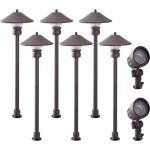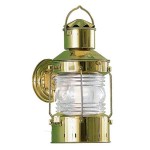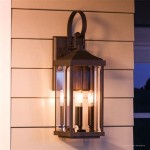Solar Lighting: Illuminating the Outdoors Sustainably
Solar lighting offers an environmentally conscious and cost-effective approach to illuminating outdoor spaces. Harnessing the power of the sun, these lighting systems provide a sustainable alternative to traditional electricity-powered options, reducing carbon footprint and energy consumption. The technology has advanced significantly in recent years, making solar lighting a viable and appealing choice for a broad range of applications, from residential gardens to commercial landscapes.
The fundamental principle behind solar lighting lies in the photovoltaic effect. Solar panels, composed of semiconductor materials like silicon, convert sunlight into electricity. This electricity is then stored in rechargeable batteries, typically lithium-ion or nickel-metal hydride, for later use. At dusk, a light sensor automatically triggers the lighting system to turn on, drawing power from the charged batteries. During daylight hours, the cycle repeats, recharging the batteries and preparing the system for the next night.
The components of a typical solar lighting system include: a solar panel – the element responsible for capturing sunlight and converting it to electricity; a rechargeable battery – the energy storage component; a light source – typically an LED (Light Emitting Diode) chosen for its energy efficiency and long lifespan; a control circuit – which will regulate the charging and discharging of the battery as well as control the light output based on light sensor reading; and a housing unit to protect the components from weather elements.
Energy Efficiency and Cost Savings
One of the primary advantages of solar lighting is its exceptional energy efficiency. LEDs, the mainstay of solar lighting systems, consume significantly less electricity compared to traditional incandescent or halogen bulbs. This translates to substantial cost savings over the lifespan of the lighting system, especially considering that the energy source - sunlight - is freely available and abundant. The upfront investment in solar lighting systems is frequently offset by the elimination of electricity bills associated with outdoor lighting.
Apart from the direct savings on electricity bills, solar lighting also reduces the demand on electrical grids. By utilizing renewable energy, these systems contribute to a more sustainable energy infrastructure, reducing reliance on fossil fuels and mitigating the environmental impacts associated with electricity generation. This aligns with global efforts to promote cleaner energy sources and reduce carbon emissions.
The reduced maintenance requirements of solar lighting also contribute to long-term cost savings. LEDs have a significantly longer lifespan than traditional bulbs, reducing the frequency of replacements. Furthermore, solar lighting systems typically require minimal maintenance, eliminating the need for regular servicing or repairs, unlike wired electrical system that might be subjected to wear and tear.
Environmental Benefits and Sustainability
Solar lighting's positive impact on the environment is a key factor driving its increasing popularity. Unlike traditional lighting systems that rely on electricity generated from fossil fuels, solar lighting leverages a clean and renewable energy source. This reduces the emission of greenhouse gases and other pollutants associated with electricity generation, contributing to a healthier environment.
The reduced reliance on fossil fuels also helps conserve natural resources. By utilizing solar energy, we diminish the need to extract and burn fossil fuels, which are finite resources. This contributes to the preservation of these resources for future generations. The materials used in the manufacturing of solar lights are also increasingly recycled material, further reducing their environmental footprint.
Solar lighting further supports sustainability by minimizing light pollution. Many solar lighting systems are designed to direct light downward, reducing the amount of light that escapes into the night sky. This minimizes disruption to nocturnal ecosystems and improves visibility for stargazing. Furthermore, the reduced energy consumption of solar lighting contributes to a lower overall environmental impact, promoting a more sustainable lifestyle.
Installation Flexibility and Ease of Use
The ease of installation and flexibility offered by solar lighting systems are significant advantages. Unlike traditional wired lighting systems, solar lights do not require complex wiring or electrical connections. This simplifies the installation process, making it accessible to a wider range of individuals and reducing the need for professional electricians. Many solar lighting systems are designed for easy self-installation, requiring only basic tools and minimal technical expertise.
The absence of wiring also provides greater flexibility in terms of placement. Solar lights can be positioned virtually anywhere that receives sufficient sunlight, without being constrained by the proximity of electrical outlets. This allows for creative and customized lighting designs that enhance the aesthetic appeal of outdoor spaces. Solar lights are highly portable which means they can easily be relocated to different areas.
Solar lighting systems are also designed for ease of use. Most systems operate automatically, turning on at dusk and off at dawn without any manual intervention. Some systems also feature adjustable brightness levels or motion sensors, allowing users to customize the lighting to their specific needs and preferences. This provides added convenience and control, enhancing the overall user experience.
The lifespan of solar lights can depend on the quality of components, the amount of sun exposure and the maintenance of the lights. When selecting solar lights, it is important to research the quality of the solar panels, battery and LEDs. Ensure the selected lights have a good warranty so that if there are issues with the light, they can be fixed or replaced. The location of the light is important as it needs to be in an area where it can get direct sunlight to charge the batteries. Keeping the solar panel clean will also increase the efficiency of the solar panels and will lead to increased lights performance.
In conclusion, solar lighting presents a compelling solution for illuminating outdoor spaces in a sustainable and cost-effective manner. Its energy efficiency, environmental benefits, and ease of use make it an increasingly attractive alternative to traditional lighting systems. As the technology continues to advance and the cost of solar panels decreases, solar lighting is poised to become an even more prevalent and accessible option for residential, commercial, and public spaces alike.

5 Best Outdoor Solar Lights Of 2024 Reviewed

Transform Your Garden With Solar Lights Eco Friendly Hoselink

2024 Best Er Solar Powered Ground Lighting Ip65 Stainless Steel Led Lights Outdoor China Garden Light Made In Com

Outdoor Solar Lanterns Driveway Landscaping Garden Lights

Super Bright Solar Lights Outdoor Waterproof 10 Pack Dusk To Dawn Up 12 Hrs Powered Pathway Garden Auto On Off Led Landscape Lighting Decorative For Walkway Patio Yard

Solar Garden Lights

Cubilan Solar Outdoor Lights Bright Pathway Waterproof Broe 8 Pack B0btyq1glw The Home Depot

90 150 200 Led Solar Fireworks Lights Outdoor Waterproof Garden Light With 8 Lighting Modes Diy Lawn Lamp For Yard Pathway Decor Temu

10 Pack Solar Lights Outdoor Decorative Pathway Powered Garden Yard For Walkway Sidewalk Driveway Brown Cool White Com

Outdoor Solar Lights Lamps Plus
Related Posts







